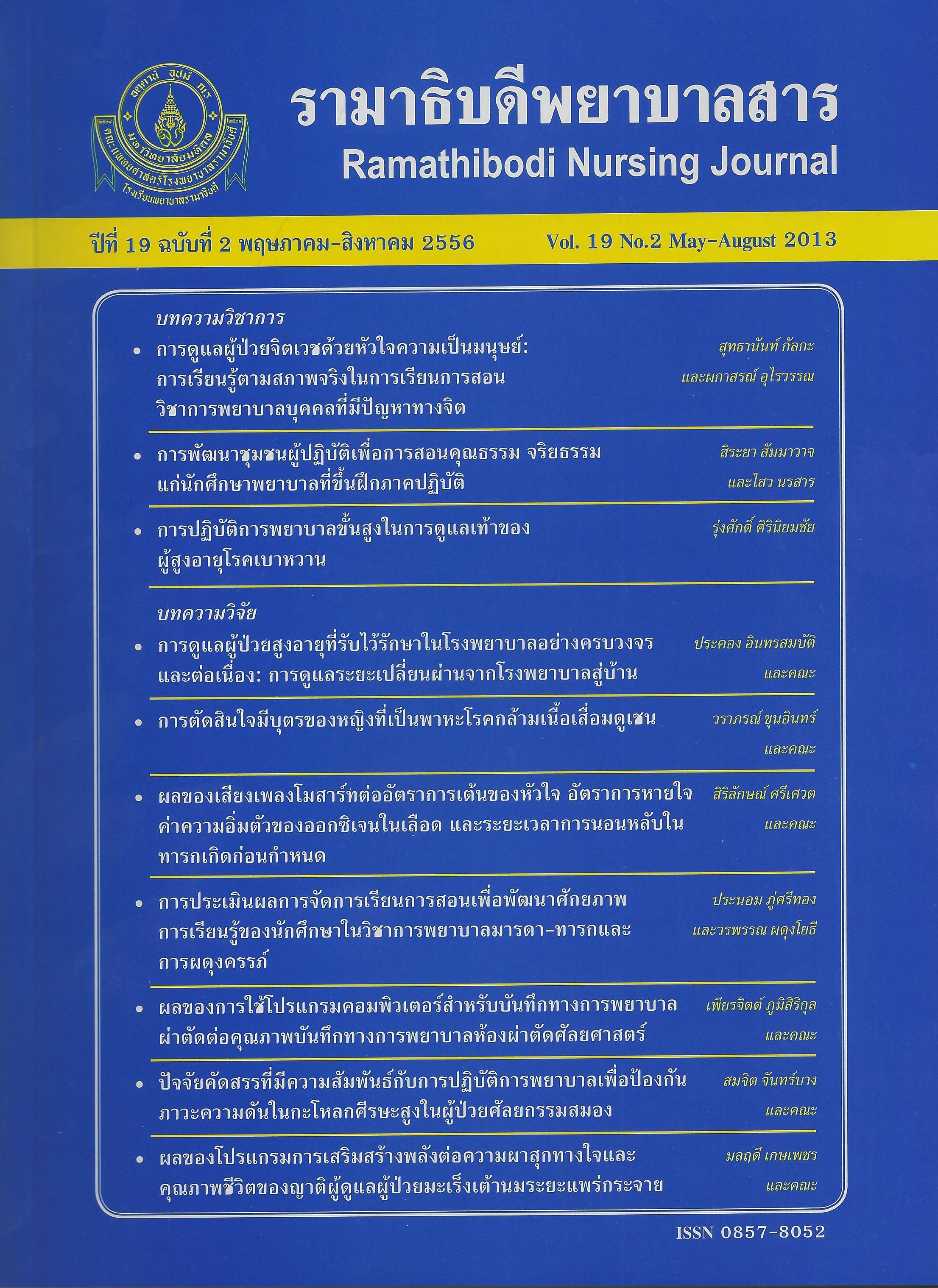ผลของเสียงเพลงโมสาร์ทต่ออัตราการเต้นของหัวใจ อัตราการหายใจ ค่าความอิ่มตัวของออกซิเจนในเลือด และระยะเวลาการนอนหลับในทารกเกิดก่อนกำหนด
Main Article Content
Abstract
บทคัดย่อ:
การวิจัยนี้เป็นการวิจัยกึ่งทดลองแบบข้ามสลับ (cross-over design) เพื่อเปรียบเทียบอัตราการเต้นของหัวใจ อัตราการหายใจ ค่าความอิ่มตัวของออกซิเจนในเลือด และระยะเวลาการนอนหลับในทารกเกิดก่อนกำหนดขณะที่ได้รับฟังเพลงโมสาร์ทและไม่ได้รับฟังเพลงโมสาร์ท ในทารกที่มีอายุครรภ์ 32-36 สัปดาห์ และได้รับการรักษาในหอผู้ป่วยทารกแรกเกิดป่วย โรงพยาบาลระดับตติยภูมิ กรมการแพทย์ กรุงเทพมหานคร ระหว่างเดือนกันยายน พ.ศ. 2553-มกราคม พ.ศ. 2554 เลือกกลุ่มตัวอย่างแบบเฉพาะเจาะจงตามคุณสมบัติที่กำ หนด จำนวน 15 ราย กลุ่มตัวอย่างถูกสุ่มทำ การทดลอง 2 สถานการณ์คือ สถานการณ์ที่ 1 ในวันที่ 1 หลังให้นมทารกแล้ว 30 นาที ทารกได้ฟังเสียงเพลงโมสาร์ทนาน 40 นาที ส่วนวันที่ 2 ทารกไม่ได้ฟังเสียงเพลงโมสาร์ท หรือสถานการณ์ที่ 2 ในวันที่ 1 หลังให้นมทารกแล้ว 30 นาที ทารกไม่ได้รับฟังเสียงเพลงโมสาร์ท ส่วนวันที่ 2 ทารกได้ฟังเสียงเพลงโมสาร์ทนาน 40 นาที และบันทึกระยะการหลับของทารกด้วยกล้องวีดิทัศน์ ประเมินการหลับตื่นโดยใช้แบบบันทึกการหลับตื่นของทารกเกิดก่อนกำหนดและคู่มือการประเมินพฤติกรรมการหลับตื่นของทารกเกิดก่อนกำหนด วิเคราะห์ข้อมูลโดยใช้สถิติบรรยายและสถิติที ผลการศึกษาพบว่า อัตราการหายใจ ณ นาทีที่ 10, 20, 30, และ 40 ขณะที่ได้รับฟังเพลงโมสาร์ทมีค่าเฉลี่ยน้อยกว่าขณะที่ไม่ได้รับฟังเพลงโมสาร์ท อย่างมีนัยสำคัญทางสถิติ และระยะเวลาการนอนหลับในทารกเกิดก่อนกำหนดขณะที่ได้รับฟังเพลงโมสาร์ท 40 นาที มีค่าเฉลี่ยนานกว่าขณะที่ไม่ได้รับฟังเพลงโมสาร์ทอย่างมีนัยสำคัญทางสถิติ ส่วนผลของเสียงเพลงโมสาร์ทต่ออัตราการเต้นของหัวใจ และความอิ่มตัวของออกซิเจนในเลือดนั้นยังสรุปได้ไม่ชัดเจน จึงควรมีการศึกษาเพิ่มเติม จากผลการวิจัยนี้สามารถใช้เป็นแนวทางในการปฏิบัติการพยาบาล เพื่อส่งเสริมการนอนหลับในทารกเกิดก่อนกำหนดได้
คำสำคัญ: ทารกเกิดก่อนกำ หนด เพลงโมสาร์ท สัญญาณชีพ ค่าความอิ่มตัวของออกซิเจนในเลือด ระยะเวลาการนอนหลับ
Abstract:
A cross-over experimental research design was used to compare the heart rate, respiratory rate, oxygen saturation, and total sleeping duration while listening to Mozart’s music and when not listening to Mozart’s music in preterm infants from 32 to 36 weeks of gestation who were admitted to the sick newborn unit of tertiary care hospital from September 2010 to January 2011. Fifteen participants were recruited by purposive sampling. The sample in this study was divided into two conditions. For the first condition, preterm infants listened to Mozart’s music for 40 minutes on the first day after feeding 30 minutes, but did not listen to Mozart’s music on the second day. For the second condition, preterm infants did not listen to Mozart’s music on the first day, but listened to Mozart’s music for 40 minutes after feeding 30 minutes on the second day. The video recorder observed the sleeping duration among the preterm infants. The evaluation was also conducted using infants’sleep-wake record form and sleep-wake behavior evaluation guideline for preterm infants. The data was analyzed using descriptive statistics and paired t-test. Findings indicated that the mean respiratory rate at 10, 20, 30 ,40 minutes among preterm infants while listening to Mozart’s music decreased more than those who did not listen to Mozart’s music with statistical significance. The mean of the total sleeping duration during listening to Mozart’s music for 40 minutes was longer than those who did not listen to Mozart’s music with statistical significance. However, the effects of Mozart’s music on heart rate and oxygen saturation were not clear and need further study. The results from this study can be used as a guide for nursing practice to promote sleep among preterm infants.
Keywords: Preterm infants, Mozart’s music, Vital signs, Oxygen saturation, Sleep duration
Article Details
บทความ ข้อมูล เนื้อหา รูปภาพ ฯลฯ ที่ได้รับการตีพิมพ์ในรามาธิบดีพยาบาลสาร ถือเป็นลิขสิทธิ์ของวารสาร หากบุคคลหรือหน่วยงานใดต้องการนำทั้งหมดหรือส่วนหนึ่งส่วนใดไปเผยแพร่หรือเพื่อกระทำการใด ใด จะต้องได้รับอนุญาตเป็นลายลักษณ์อักษรจากรามาธิบดีพยาบาลสารก่อนเท่านั้น


